Although there are nearly 200 countries in the world, some are so compact that you could traverse them in a single afternoon.
Despite their size, many of these nations make a large impact culturally, historically, or politically.
Here are ten of the smallest countries on Earth by land area:
1. Vatican City (~0.44 sq km)
Nestled within Rome, this is the world’s tiniest independent state. It’s the heart of the Roman Catholic Church and home to the Pope. Despite its tiny footprint, Vatican City draws millions yearly thanks to landmarks like St. Peter’s Basilica and the Sistine Chapel.
2. Monaco (~2 sq km)
Located on the French Riviera, Monaco is synonymous with luxury: glamorous events (think Grand Prix), upscale casinos, and no income tax. Its small size hasn’t prevented it from becoming one of the most densely populated and iconic places in Europe.
3. Nauru (~21 sq km)
This Pacific island nation, once prosperous due to its phosphate mining, has had to adapt after resources dwindled. Sitting just above the equator, Nauru depends heavily on imports and international cooperation to sustain its economy.
4. Tuvalu (~26 sq km)
Tuvalu is made up of nine small islands scattered across the Pacific. One of its most pressing concerns is climate change: rising sea levels pose a real threat to its land and way of life.
5. San Marino (~61 sq km)
Enclosed within Italy, San Marino claims to be among the oldest republics in the world, formally founded in the early fourth century. It supports its economy through tourism, small-scale manufacturing, and banking, all while fiercely preserving its independence.
6. Liechtenstein (~160 sq km)
Situated between Switzerland and Austria, Liechtenstein combines alpine beauty with economic stability. It’s known for strong financial sectors, low unemployment, and more registered businesses than residents in some instances.
7. Marshall Islands (~181 sq km)
A collection of coral atolls and more than a thousand islands in the central Pacific, this nation is famous for stunning lagoons and rich marine life. However, its history includes painful chapters, such as U.S. nuclear testing, the effects of which are still felt today.
8. Saint Kitts and Nevis (~261 sq km)
The smallest sovereign state in the Western Hemisphere, this two-island country in the Caribbean is lush and tropical. Sugarcane plantations once dominated its economy, but now tourism plays the lead role in bringing in revenue.
9. Maldives (~298 sq km)
The Maldives are made up of nearly 1,200 coral islands scattered across the Indian Ocean. Famed for their luxury resorts, crystal-clear waters, and vibrant marine ecosystems, they are increasingly vulnerable to environmental threats, especially rising seas.
10. Malta (~316 sq km)
Situated in the Mediterranean between Sicily and the North African coast, Malta blends ancient history with modern life. Its fortified cities, ancient temples, and busy maritime trade make it more than just another pretty island.


